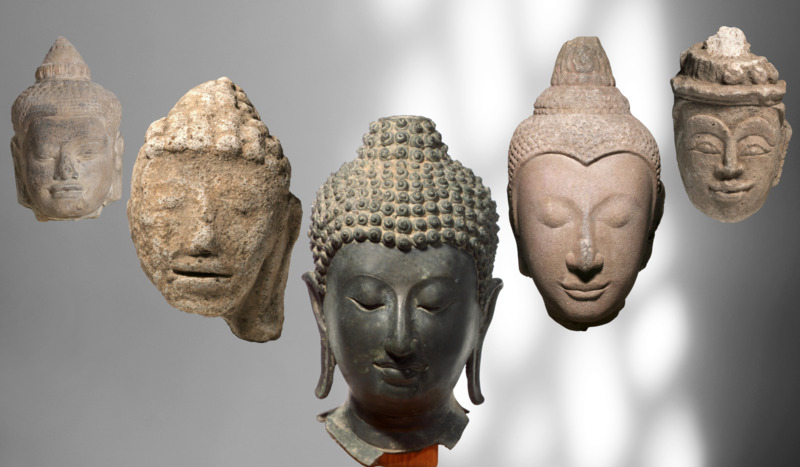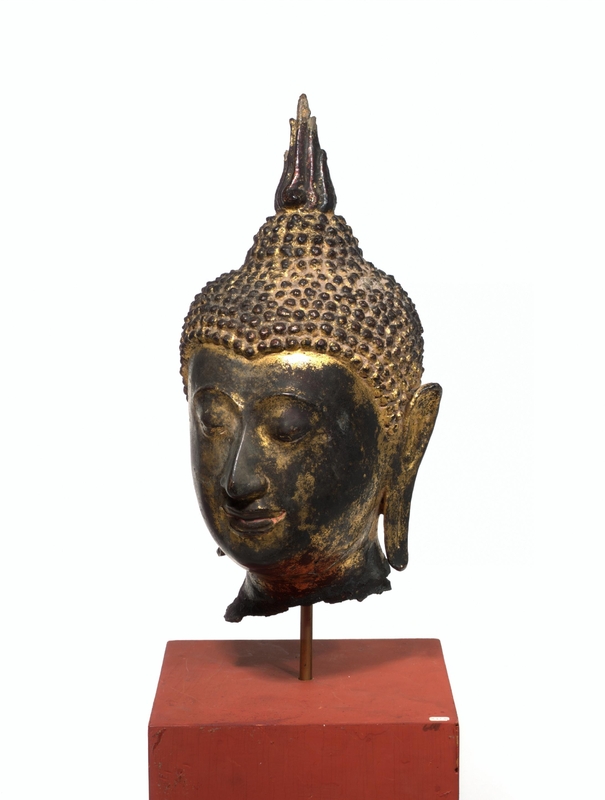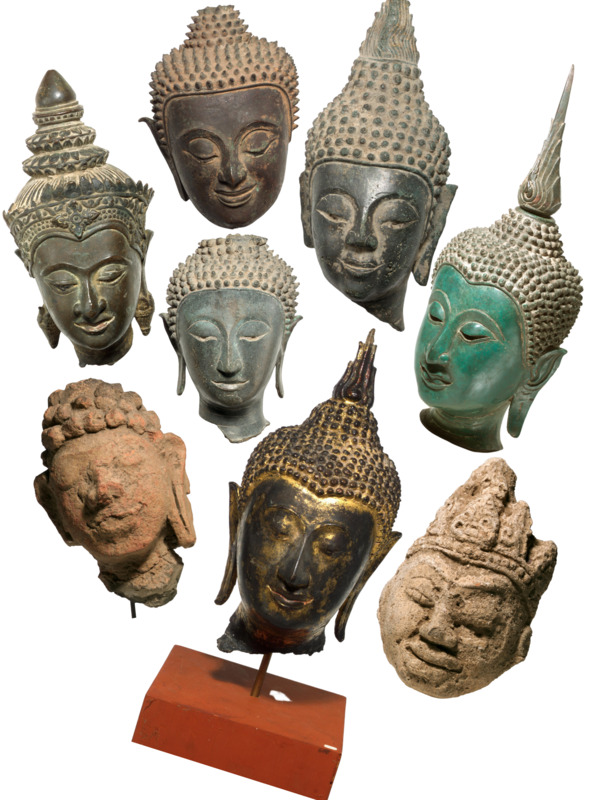Travels of Buddha Heads
In a 1976 feature on Griswold and the Breezewood Collection in the Baltimore Sun Magazine by J. Wynn Rousuck, Mr. Griswold relates that the first pieces he ever bought in 1945 in Bangkok were small, sculpted, detached heads. “They were plentiful and cheap in those days,” he said (1976:19). Within six years, he had acquired most of his objects from Thailand, and his overall collection was comprised of almost 200 objects from Asia. Griswold sought to create a comprehensive collection of Thai Buddhist sculpture that could indicate historical patterns, adaptations, and transformations of aesthetics and beliefs, but following that active period in the late 1940s and early 1950s, he stopped collecting by 1956. In Sacred Sculpture of Thailand, the catalogue and exploration of Griswold’s collection, art historian Hiram Woodward states,
In later years, Griswold’s attitude toward the great collection he had formed sometimes seemed distant, though he clearly recognized the importance of the most significant works of art. At one of his Breezewood seminars, his only reference to any of the objects in the room where the seminars were held was to a forgery of a Dvaravati bronze, in which the perpetrator had misunderstood what was supposed to be a robe-end between the Buddha’s fingers. ‘And the Buddha,’ Griswold informed the group with a twinkle in his eye, ‘doesn’t hold a cigar!’ (1997:14).
The language of pleats and folds emerges in a moment of lighthearted banter that belies deeper ambivalence. Like earlier scholars who Griswold charged with not quite knowing what to make of the garments worn by Buddha images, Griswold no longer knew what to make of his own collection. This uncertainty also surfaces in the profile by Rousuck from 1976, almost 30 years after Griswold’s glowing remarks about the similarities between Baltimore and Bangkok and resulting affective ties to his collection. He describes his first acquisitions as “tiny, cheap heads not worth exhibiting.” Rousuck continues, “Mr. Griswold is soft-spoken but direct. He admits, ‘I never had much of a love for Thailand. I think serious people should avoid loving 40 million people.’ Despite the size and scope of his collection he says, ‘I don’t really enjoy collecting. It doesn’t leave enough time for research’” (1976:19).
This change highlights how humans’ relationships with material things are never fixed but subject to change and to revision – a person does not have to be an expert or amateur collector to gradually feel less attached to certain formerly beloved possessions. However, scholars characterize people who intentionally gather and group objects into collections as sharing a common impulse, or even a mania, to collect; the sometimes-and-seemingly-irrational, insatiable desire to possess, and the hold that the collection has over its owner, cast a collector’s eschewing of their collection in fraught, cathartic terms. Perhaps Griswold did not experience such a sudden break from his collection, but his dismissal of collecting brings crucial political economic dimensions to light. Woodward speculates that Griswold’s distance was due in part to his shift in research focus from art history to epigraphy, which he undertook with the help of Ajan Prasert na Nagara mentioned above and in the interview with Ajan Thak. His longstanding interest in textual studies and his passion for decoding stubbornly complex messages is evident in his approach to the Buddha’s Three Garments, whose flowing folds Griswold theorizes as signs that can be read. In letters he wrote to one of his mentors, George Cœdès, additional possible reasons for his detached stance emerge; Griswold was increasingly dismayed by the “alarming” and “astonishing” situation of the “mutilation” of statues in Thailand, noting in 1966 that many Buddha images had their heads and hands cut off to meet the demands of the burgeoning antiquities market, as tourists preferred to buy these parts but not bodies (Griswold papers, #4290).
Nevertheless, many such heads over which Griswold lamented were also part of his collection, material reminders of the Westward travels of potentially looted artifacts from Southeast Asia that have found their way into museums and private residences since the long period of colonization. Their removal from archaeological and living sacred sites rips them out of context with multifarious violent implications. Scholars assert that in Southeast Asia, the excavation of antiquities specifically to supply collectors was negligible until the 1950s, and the 1960s “discovery” of the Bronze Age site at Ban Chiang, Udon Thani, Thailand was a watershed moment for unauthorized digging of archaeological sites. In a 1978 paper, Woodward estimated that as many as 90% of the ancient monuments in Northeast Thailand had been severely damaged by looters.
Yet these flows are not unilinear. Sculpture, ceramics, and other antiquities circulated throughout Southeast Asia and arrived in the hands of both foreign and local collectors and institutions, especially during the chaos and violence fueled by American intervention in the region from the 1950s through 1990s. Interdisciplinary heritage scholar Denis Byrne asks us to consider the culture and stakes of collecting among members of the elite and middle class in Southeast Asia. Nation-states like Thailand and Cambodia do not simply “supply” objects in the global antiquities trade; thriving domestic antiquities markets attest to how these material things become implicated in local regimes of value, oftentimes buttressing nationalist historical narratives that only increase acquisitive desires (Byrne 2016).
Contemporary discourses around looting and extractive patterns of procurement emphasize the urgency of repatriation of the stolen goods that fill museums and private collections in the West and bestow upon their owners undeserved prestige and other forms of social and economic capital. Calls for repatriation are crucial, sometimes resulting in the return of objects to their countries or communities of origin, and requiring us to confront complex, enfolded questions that destabilize concepts of property, ownership, and what counts as knowledge. Where and with whom do these objects belong? How should such decisions be made? What can be done when a single answer or solution will never be sufficient in the face of irreparable damage?
Griswold and others featured in this exhibit do diverge somewhat from the archetype of the nefarious collector or art dealer that often emerges in debates over repatriation. This archetype is borne out in accounts of the activities of people like Douglas A.J. Latchford, who was charged in 2019 with trafficking Cambodian objects over many decades. Latchford took advantage of unrest in Cambodia, often falsified provenance records to obscure a known history of looting, and encouraged others to do the same, all the while styling himself as a “rescuer” of abandoned works of art (McGreevy 2021). Looters like Latchford also keep objects hidden away in their homes, preventing people from learning from them, and in the case of many objects with religious and cosmological significances, depriving the objects and their source communities of proper care, propitiation, and connections to history. Art historian Ashley Thompson and curator Stephen Murphy emphasize,
It is impossible to undo the damage done to Cambodia by decades of looting, which both exploited and contributed to the fragility of Cambodian society during and after the wars of the late-20th century. Each stolen statue, each defaced temple, ripped at the heart of a social order organised around veneration of ancestors embodied in the ancient sculpted stones. Even on their return, the statues cannot go back to a social setting that is virtually gone.
Likewise, it is impossible to undo the damage done to the knowledge of ancient Cambodia embodied by the art in situ. For the looting also stripped the materials of their historical settings. While objects will finally be returned to a museum, there is only so much they can now tell us about the ancient history of which they were once integral parts (2021).
Griswold’s collection is a record of these kinds of interlinked loss, even as it has always existed in relation to various publics. Today, it is split between Ithaca and Baltimore, with at least 165 objects held by the Walters Art Museum. Even before his collection entered these institutions, it could be viewed on the first Sunday of every month, when visitors were invited to Breezewood to tour its gardens and to engage with Griswold’s art as it was displayed in his home. In 1976, he estimated that 10 to 20 people stopped by on a typical Sunday, and he received approximately 200 to 300 visitors per year. In 1956, he wrote an in-depth guide to the collection for guests to use. Finally, the collection was the focal point of the aforementioned annual Breezewood Seminars, when students and faculty from Cornell drove together to Maryland to spend three days surrounded by sculpture and immersed in the lectures delivered by Griswold.
Works Cited
Byrne, Denis. “The problem with looting: an alternative view of antiquities trafficking in Southeast Asia.” Journal of Field Archaeology 41(3) 2016: 344-354.
McGreevy, Nora. “Collection of antiquities dealer accused of looting will return to Cambodia.” Smithsonian Magazine, 2 February 2021, Accessed 6 April 2021.
Rousuck, J. Wynn. “Surprise Beyond the Trees: One of the Country’s Best Collections of Siamese Art.” Baltimore: The Sun Magazine, June 6, 1976.
Thompson, Ashley and Stephen Murphy. “Cambodia is turning the tide on looted statues, but some things cannot be returned.” The Guardian. 12 Feb 2021, Accessed 6 April 2021. https://www.theguardian.com/commentisfree/2021/feb/13/cambodia-looted-statues-ancient-khmer-objects
Woodward, Hiram W. The Sacred Sculpture of Thailand: the Alexander B. Griswold Collection, the Walters Art Gallery. Baltimore, Md.: Walters Art Gallery, 1997.
Woodward, Hiram W. “History of Art: Accomplishments and Opportunities, Hopes and Fears,” in E. Ayal, ed., The Study of Thailand. Ohio University Center for International Studies, Southeast Asia Series No. 54. Athens: Ohio University Center for International Studies, 1978.
Next:




